Software Developer Salaries 2024: Top 20 Languages

Technology is always evolving, with new tools, coding languages, and frameworks emerging all the time.
Understanding the most lucrative programming skills is crucial for anyone curious about how these skills impact earnings. The right expertise can significantly boost career growth and salary potential.
This guide looks at the 20 most in-demand programming languages in 2024. Whether you are interested in tech trends or a professional looking for detailed salary information, this guide is extremely useful.
Find out which programming skills are in demand right now. Learn what coding knowledge commands the biggest salaries and why.
Quick Navigation: Top 20 Programming Languages
- Python
- Java
- JavaScript
- C#
- C/C++
- R
- PHP
- TypeScript
- Swift
- Rust
- Objective-C
- Go (Golang)
- Kotlin
- SQL
- Ruby
- VBA
- Powershell
- Ada
- Scala
- Perl
1. Python
Python is a highly influential and widely adopted programming language renowned for its simplicity and readability, making it an ideal choice for beginners.
As a free, open-source language, Python boasts a robust ecosystem of modules and a vibrant community that contributes to its continuous development.
Its compatibility with web services and user-friendly data structures make it a versatile tool for a variety of applications.
Applications of Python across industries
Python is incredibly versatile, finding utility in numerous fields. It is essential in the development of both 2D imaging and 3D animation software, with notable applications including Blender, Inkscape, and Autodesk.
The gaming industry also leverages Python in the creation of popular titles such as Civilization IV and Toontown.
Moreover, Python’s capabilities in scientific computing and data analysis make it a staple in academic and research settings, utilized in tools like FreeCAD and Abaqus.
Significant for the tech industry, Python powers many of the web’s most trafficked sites, such as YouTube, Quora, Pinterest, and Instagram, showcasing its scalability and robustness in handling web applications.
Required skills for Python developers
Developers should have a solid grasp of object-oriented programming, data structures, version control, and debugging.
Additionally, experience with frameworks such as Django for web applications or Pandas for data analysis can be crucial.
Python’s versatility
Python’s adaptability extends across platforms. It is used in developing web applications, desktop apps, network servers, and even tools for machine learning and deep learning.
Its broad utility makes it an essential skill for developers working across various computing platforms.
Benefits of Python
- Ease of learning: Python’s clear syntax mirrors natural language, which simplifies the learning process for new programmers.
- Extensive libraries: A rich selection of libraries and frameworks greatly enhances Python’s functionality.
- Community support: A large, active community provides extensive resources and troubleshooting assistance.
Drawbacks of Python
- Performance limitations: Python can be slower than compiled languages like C and Java, which may be a drawback in performance-critical applications.
- Runtime errors: Its dynamic nature can sometimes lead to unexpected runtime errors, requiring thorough testing and debugging.
Python continues to be a top choice for developers due to its versatility, readability, and strong community. Whether you’re developing web applications, diving into machine learning, or building game engines, Python offers a powerful toolkit for all kinds of programming challenges.
The popularity of Python over the years
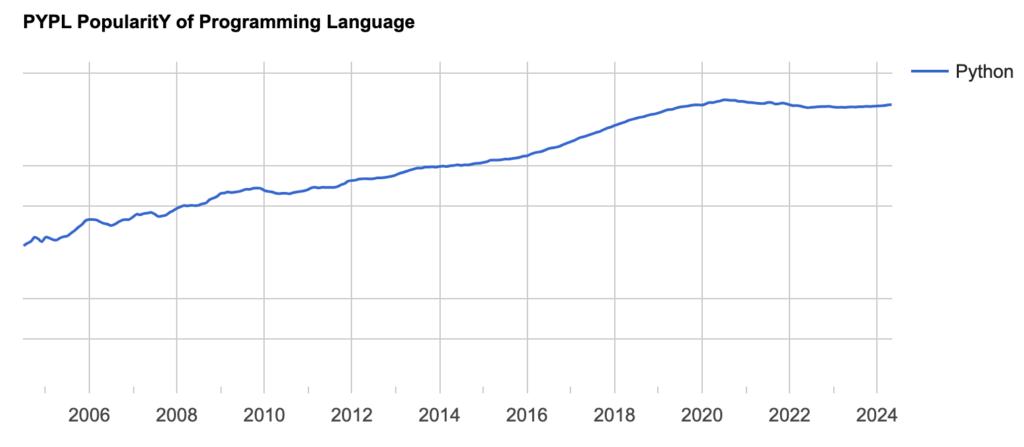
Python developers’ salary
The financial rewards for Python developers are attractive, reflecting their demand across various sectors.
Historically, salaries ranged from around $60,000 to over $180,000 per year, depending on the developer’s experience, industry, and location.
In the U.S., the average base salary is $125,081, with an average hourly rate of $60.
Seasoned Python developers often command significantly higher wages due to their specialized expertise.
Upwork Data
Python developer average hourly rate – 93$ (for a 100% job success rate)

2. Java
Java stands out as one of today’s most popular programming languages, widely adopted due to its versatility and robust structure.
Owned by Oracle Corporation, Java is a general-purpose, object-oriented language, notable for its “Write Once, Run Anywhere” (WORA) capability.
This feature enables Java applications to operate seamlessly across platforms like Mac, Windows, Android, and iOS, making it highly portable from mainframe data centers to smartphones.
As a testament to its ubiquity, over 3 billion devices currently run Java-based applications.
Applications of Java across projects and Industries
Java finds significant use in web and application development, as well as in big data processing.
It serves as the backbone of numerous popular websites such as Google, Amazon, Twitter, and YouTube. Its adaptability extends to mobile applications, desktop software, and even embedded systems.
Additionally, modern Java frameworks like Spring, Struts, and Hibernate simplify complex development tasks, further enhancing Java’s appeal.
Skills required for Java developers
Java developers should have a strong grasp of object-oriented programming principles and be proficient at writing and maintaining Java code using IDEs like IntelliJ IDEA or Eclipse.
Familiarity with frameworks like Spring or Struts is often necessary for web development roles.
Experience with version control, debugging, and build automation tools like Maven or Gradle is also advantageous.
Java’s compatibility
Java’s versatility allows it to be used in developing web, mobile, and desktop applications. It can run on almost any device or operating system, thanks to the Java Virtual Machine (JVM).
This adaptability makes it indispensable for organizations requiring scalable and cross-platform software solutions.
Benefits of Java
- Portability: Java’s WORA philosophy ensures application functionality across platforms with minimal modifications.
- Scalability: Suitable for projects ranging from small apps to enterprise-grade systems.
- Community Support: Millions of Java developers worldwide create a vast problem-solving support network.
- Mature Ecosystem: A wide array of frameworks and tools enhance productivity.
Drawbacks of Java
- Performance: Java programs can sometimes be slower than those written in lower-level languages due to the JVM.
- Memory Usage: Java applications tend to consume more memory, which can be a limitation in resource-constrained environments.
The popularity of Java over the years
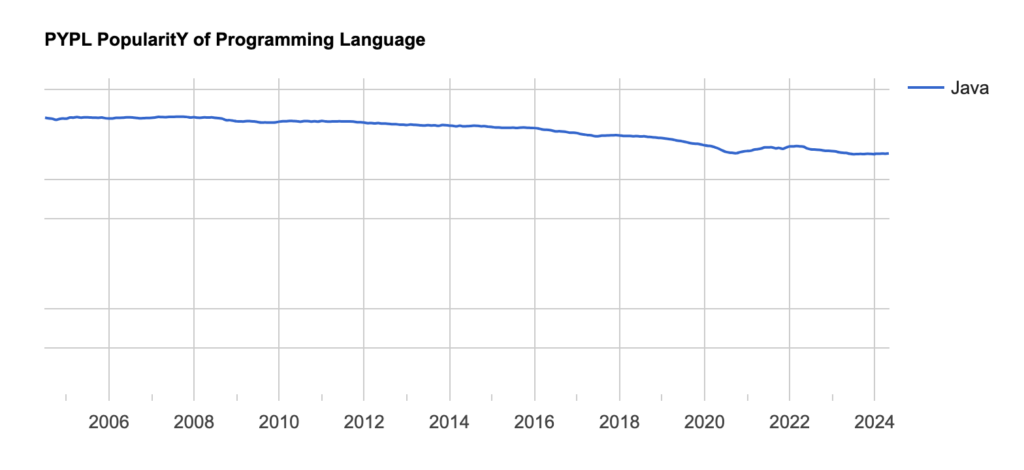
Java developers’ salary
Historically, Java developers have earned salaries ranging from around $60,000 to over $150,000 annually, depending on expertise and industry.
In the U.S., the average base salary is $120,000, with an average hourly rate of $58. These figures reflect the strong demand for Java skills across various sectors.
Upwork Data
Java developer average hourly rate – 75$ (for a 100% job success rate)

3. JavaScript
JavaScript is a high-level programming language that’s a foundational technology of the Web. It is the client-side programming language used by over 97% of websites.
Initially designed to develop web browsers exclusively, JavaScript now powers server-side deployments and non-browser applications, solidifying its place as a versatile, cross-platform language.
Developed in 1995 and originally known as LiveScript, JavaScript was rebranded to align with the popular Java language of the time.
Though often confused with Java, JavaScript is distinct, offering unique syntax and capabilities.
Over the years, JavaScript has evolved into an independent, fully-fledged language and a critical component of modern software development.
Applications of JavaScript across projects and industries
JavaScript is indispensable for interactive web applications and plays a key role in dynamic content. It enables rich client-side experiences, from interactive forms and real-time updates to responsive animations.
In recent years, frameworks like Node.js have brought JavaScript to the server side, empowering full-stack developers to handle backend and front-end development with the same language.
Beyond web development, JavaScript is used in desktop and mobile apps via frameworks like Electron and React Native, allowing developers to craft cross-platform solutions efficiently.
It’s also instrumental in building progressive web apps, which offer app-like experiences directly in browsers.
Skills needed for JavaScript developers
To excel in JavaScript development, professionals should understand core language features such as functions, asynchronous programming, and the Document Object Model (DOM).
Mastery of popular frameworks like React, Angular, or Vue is highly valued for frontend work, while Node.js knowledge is essential for backend development.
Familiarity with version control, debugging, and building tools like Webpack or Babel is also beneficial.
JavaScript’s compatibility
JavaScript is truly cross-platform, enabling development across web, desktop, and mobile applications. With frameworks like React Native and Electron, developers can build mobile and desktop apps while using the same JavaScript codebase.
Benefits of JavaScript
- Cross-platform compatibility: Develop applications across web, desktop, and mobile platforms using one language.
- Rich ecosystem: A vast array of frameworks, libraries, and tools simplifies development.
- Real-time interactivity: Enables dynamic and interactive user interfaces in web applications.
Drawbacks of JavaScript
- Security vulnerabilities: Client-side JavaScript can be susceptible to security issues like cross-site scripting (XSS).
- Browser inconsistency: Some features may not work uniformly across all browsers, requiring additional testing and adjustments.
The popularity of JavaScript over the years

JavaScript developers’ salary
JavaScript developers are well-compensated, with historical salaries ranging from $60,000 to $150,000 depending on expertise and industry.
In the U.S., the average base salary is $117,000, while the average hourly rate is $56.
Upwork Data
JavaScript developer average hourly rate – 44$ (for a 100% job success rate)
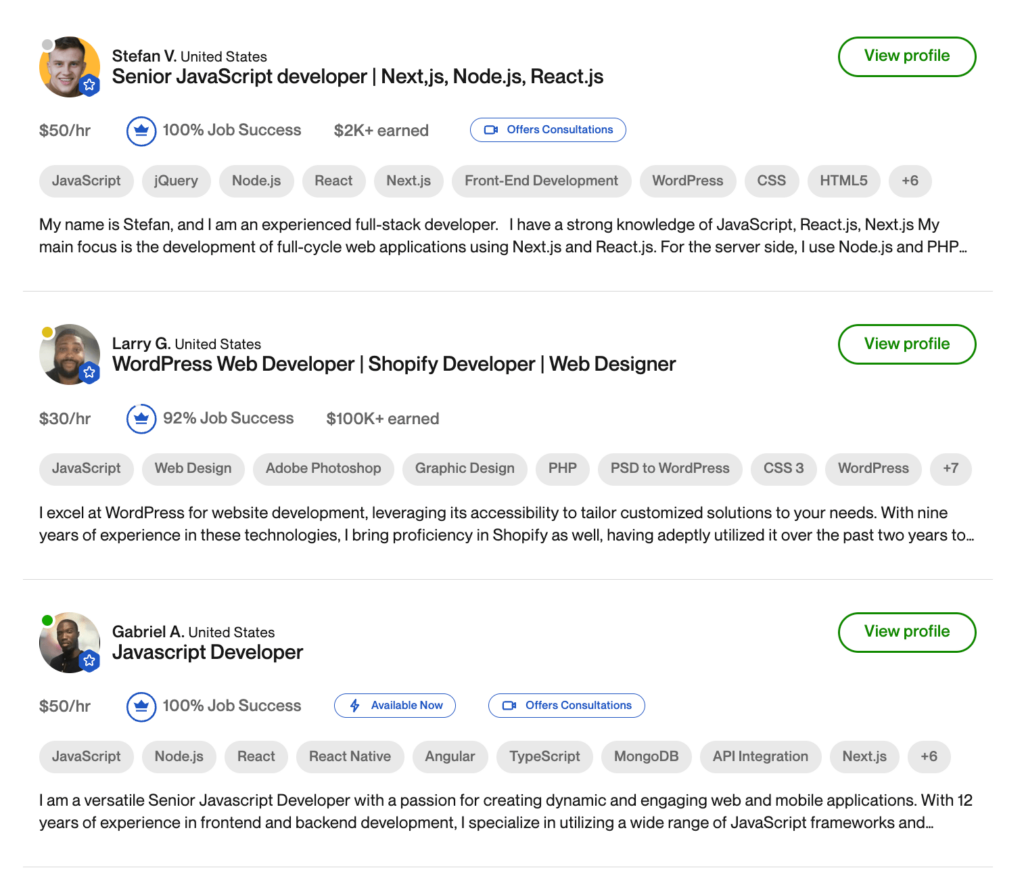
4. C#
C# is a powerful programming language developed by Microsoft, gaining significant popularity in the 2000s due to its comprehensive support for object-oriented programming principles.
According to its creator, Anders Hejlsberg, C# shares more similarities with C++ than Java, offering robust functionality for developers.
As a key language in the .NET framework, it remains one of the most widely used tools for creating cross-platform applications.
Applications of C# across projects and industries
C# is ideal for developing applications on Windows, Android, and iOS, leveraging Microsoft’s Visual Studio integrated development environment (IDE) for streamlined coding.
It’s also essential for building enterprise software applications, making it a valuable asset for organizations seeking efficient, scalable solutions.
This language powers the back end of various well-known websites, including Bing, Dell, MarketWatch, and Microsoft’s Visual Studio platform.
Additionally, C# is popular for game development using the Unity engine, which enables developers to create visually rich and interactive gaming experiences.
Skills needed for C# developers
Proficiency in C# requires a solid understanding of object-oriented programming principles and familiarity with the .NET framework.
C# developers should be comfortable working within the Visual Studio IDE and know about version control, debugging, and testing tools.
Knowledge of key C# frameworks like ASP.NET for web development or Xamarin for mobile applications is also advantageous.
Compatibility of C#
C# is inherently cross-platform, allowing developers to build web, desktop, and mobile applications. Its compatibility with the .NET framework and tools like Xamarin ensures seamless development for Windows, Android, iOS, and even cloud-based solutions.
Benefits of C#
- Cross-platform development: Enables app creation across web, desktop, and mobile platforms.
- Unified ecosystem: Tight integration with the .NET framework simplifies building and maintaining applications.
- Comprehensive tools: Microsoft’s Visual Studio IDE provides robust features for development, debugging, and testing.
Drawbacks of C#
- Windows-centric: C# may require additional effort or resources to work efficiently on non-Windows platforms.
- Learning curve: Developers transitioning from non-object-oriented languages may face challenges learning C#’s syntax and structure.
The popularity of C# over the years
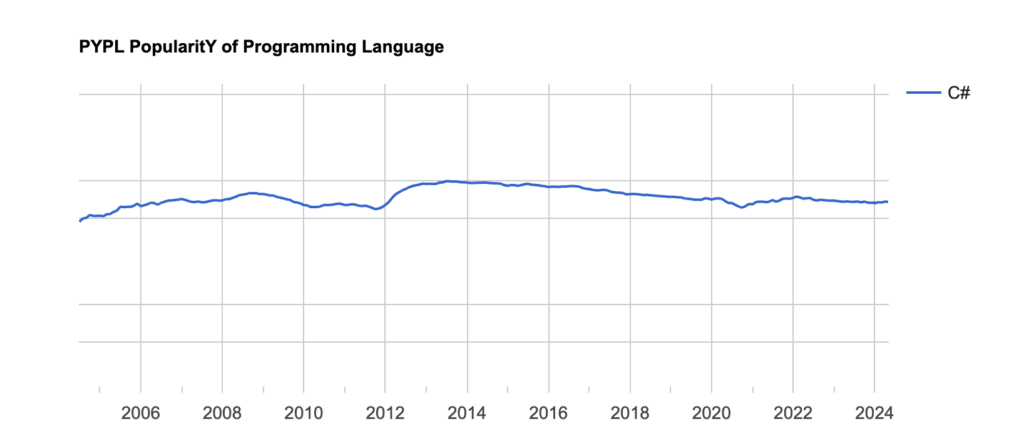
Salary of C# developers
Historically, C# developer salaries ranged from $55,000 to over $130,000, reflecting varying levels of expertise and industry demand.
In the U.S., the average base salary is $112,505, with an average hourly rate of $54.
With C# continuing to play a pivotal role in enterprise software and cross-platform development, skilled professionals will remain in high demand.
Upwork Data
C# developer average hourly rate – 73$ (for a 100% job success rate)

5. C and C++
The C programming language is one of the oldest and most enduring, serving as a cornerstone for C#, Java, and JavaScript. C++ evolved from C, adding advanced features and improvements.
Although many developers learn C++ directly, mastering C first can provide a strong foundation for understanding C++’s intricacies. In computer science and programming, both languages are crucial.
Applications of C and C++ across projects and industries
C and C++ are highly portable due to their ability to leverage compilers across numerous platforms. This makes them ideal for developing cross-platform applications.
They are both considered high-performance languages, which is why they’re frequently chosen for projects where performance is critical.
C and C++ power client/server applications, commercial software like Adobe and Firefox, and high-performance video games.
They also play a significant role in embedded systems, enabling the development of firmware and system-level software across mobile, desktop, and embedded platforms.
Skills needed for C/C++ developers
- Solid understanding of pointers, memory management, and data structures due to their low-level nature.
- Familiarity with debugging tools and compilers
- Proficiency in managing complex codebases.
- Knowledge of algorithms and object-oriented programming (for C++)
Compatibility of C and C++
C and C++ are cross-platform languages, so you can build apps for mobile devices, desktops, and embedded systems. They can be used to write device drivers, operating system components, and software requiring direct hardware manipulation.
Benefits of C and C++
- High performance: Both languages provide granular control over memory, resulting in optimized performance.
- Portability: Applications can be compiled for various platforms, providing wide compatibility.
- Flexibility: Their versatility makes them suitable for everything from embedded systems to desktop applications.
Drawbacks of C and C++
- Complexity: The languages require careful management of memory and pointers, often resulting in a steep learning curve.
- Security risks: Due to low-level memory access, C and C++ programs can be more prone to security vulnerabilities like buffer overflows.
The popularity of C/C++ over the years
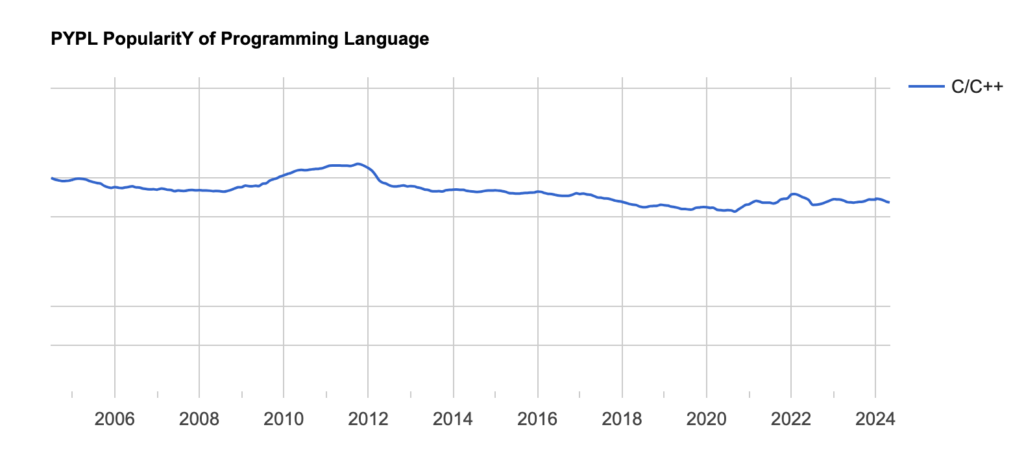
Salary of C/C++ developers
Historically, salaries for C and C++ developers ranged between $60,000 and $150,000 based on experience and the type of project.
In the U.S., the average base salary is around $112,509, with an average hourly rate of $54. There will always be a need for C and C++ developers in high-performance and embedded software.
Upwork Data
C/C++ developer average hourly rate – 135$ (for a 100% job success rate)

6. R
R is an open-source programming language that originated as an alternative to the S language. It’s designed specifically for statistical computing and data analysis.
Much of the code developed for S runs seamlessly on R, giving it backward compatibility with older projects.
Applications of R across projects and industries
R is widely used in data analysis, enabling statisticians and data scientists to perform advanced modeling, testing, and visualization. It supports both linear and nonlinear modeling, handling vast datasets easily.
Developers can use R to interface with various databases and process structured and unstructured data, making it indispensable for applications in academic research, finance, healthcare, and business analytics.
Skills needed for R developers
- A solid understanding of statistical concepts and data manipulation techniques
- Familiarity with R’s built-in functions and packages, such as ggplot2 for visualization or dplyr for data manipulation
- Knowledge of data structures and analysis tools within the R ecosystem, along with database interaction skills
Compatibility of R
R primarily operates as a desktop application through its integrated development environment (IDE), RStudio, but it’s also compatible with web-based notebooks like Jupyter.
It can run on Windows, macOS, and Linux, providing cross-platform support for data scientists and researchers.
Benefits of R
- Specialized Data Analysis: Built specifically for statistical computing, R excels at data manipulation and analysis.
- Active Community: The open-source community provides extensive support and contributes thousands of packages.
- Powerful Visualization: Offers advanced graphical tools to visualize complex data effectively.
Drawbacks of R
- Steep Learning Curve: The language requires a solid foundation in statistical analysis, which can be challenging for beginners.
- Performance Limitations: Processing very large datasets may reveal performance bottlenecks compared to some other tools.
The popularity of R over the years

Salary of R developers
Historically, salaries for R developers have ranged from $60,000 to over $130,000 annually, depending on expertise and industry.
In the U.S., the average base salary is $112,504, with an average hourly rate of $54. It’s no secret that data science is a huge field, so R professionals are going to keep making good money.
Upwork Data
R developer average hourly rate – 118$ (for a 100% job success rate)

7. PHP
PHP, an open-source programming language created in the 1990s, is widely considered an essential tool for web developers.
It powers over 80% of the world’s websites, including well-known platforms like Facebook and Yahoo.
Applications of PHP across projects and industries
PHP is used primarily for server-side scripting, allowing dynamic content and robust backends.
Beyond web development, PHP can also be utilized to write command-line scripts, and advanced PHP developers can create desktop applications with it.
This versatility has made PHP a cornerstone of web development, particularly for e-commerce platforms, content management systems, and social networking sites.
WordPress, Drupal, and Joomla are just a few examples of content management systems that leverage PHP, serving millions of websites globally.
Skills needed for PHP developers
To work effectively with PHP, developers should understand how to manipulate server-side code and handle database queries using SQL.
Familiarity with frameworks like Laravel or Symfony can significantly boost productivity, and skills in JavaScript, HTML, and CSS are essential for building comprehensive web applications.
A strong grasp of debugging, version control, and web security best practices is also crucial.
Compatibility of PHP
PHP is inherently cross-platform, enabling developers to build applications for desktop, mobile, and web environments. It integrates seamlessly with various databases and web servers, making it highly adaptable to different project requirements.
Benefits of PHP
- Ease of Learning: PHP’s syntax is straightforward, making it accessible to beginners.
- Extensive Community Support: A vast community provides a wealth of resources and advice.
- Cost-effective: As an open-source language, PHP is free and widely supported.
Drawbacks of PHP
- Security Risks: Without proper coding practices, PHP applications can be vulnerable to security issues.
- Scaling Challenges: Scaling large PHP applications may require significant architectural adjustments.
The popularity of PHP over the years
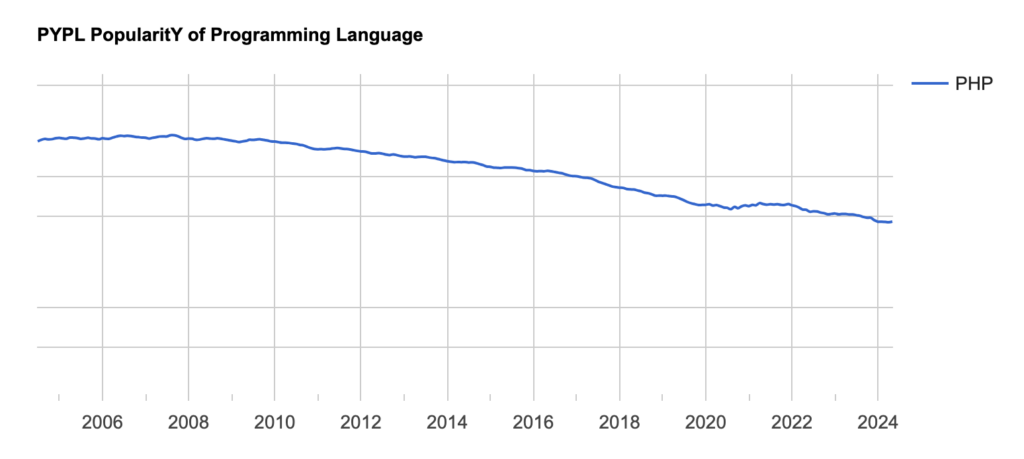
PHP developers’ salary
PHP developers‘ salaries range from $50,000 to over $120,000 a year, depending on their experience and industry.
In the U.S., the average base salary is around $102,144, with an average hourly rate of $49.
Despite shifts in web development trends, PHP remains in demand due to its integral role in maintaining and expanding existing web infrastructure.
Upwork Data
PHP developer average hourly rate – 46$ (for a 100% job success rate)

8. TypeScript
TypeScript is a relatively new, but increasingly popular programming language. Introduced by Microsoft in 2012, it builds on JavaScript by incorporating static typing, making it highly suitable for managing large codebases.
Applications of TypeScript across projects and industries
TypeScript enables developers to create complex, scalable JavaScript-based projects with a focus on both client-side and server-side development.
Its typing system helps catch errors early and prevent systemic issues, resulting in more reliable and maintainable code.
This makes it valuable for large-scale applications across industries like finance, technology, and e-commerce.
Frameworks like Angular are built with TypeScript in mind, while other major projects such as Microsoft Office and Slack also utilize it.
Skills needed for TypeScript developers
- A solid understanding of JavaScript, as the two share core syntax and concepts.
- Familiarity with type systems, object-oriented programming, and modern frameworks like Angular or React is crucial.
- Understanding how TypeScript compiles to JavaScript and integrates into existing build pipelines will enhance productivity.
Compatibility of TypeScript
TypeScript primarily targets web development but can be used in desktop, mobile, and server applications due to its compatibility with JavaScript.
Developers can leverage TypeScript to build cross-platform solutions that run in web browsers, on mobile devices, and in server environments with frameworks like Node.js.
Benefits of TypeScript
- Static Typing: Reduces runtime errors by catching mistakes at compile time.
- Scalability: Well-suited for managing large codebases due to its modular structure and enhanced tooling.
- Backward Compatibility: Code written in JavaScript can be integrated with TypeScript, easing adoption.
Drawbacks of TypeScript
- Learning Curve: Developers must adjust to TypeScript’s stricter syntax and type definitions.
- Compile Time: TypeScript code requires compilation into JavaScript, which may increase build times.
The popularity of TypeScript over the years

TypeScript developers’ salary
Depending on experience and industry, TypeScript developer salaries range from $80,000 to $160,000 a year.
In the U.S., the average base salary is approximately $132,500, with an average hourly rate of $64.
This reflects the high demand for TypeScript expertise as companies seek developers who can efficiently manage complex JavaScript projects.
Upwork Data
TypeScript developer average hourly rate – 81$ (for a 100% job success rate)

9. Swift
Swift is an open-source programming language introduced by Apple in 2014, initially designed for Linux and Mac applications.
As an accessible language that simplifies coding compared to many other programming languages, Swift retains much of the functionality found in Objective-C.
Applications of Swift across projects and industries
Swift’s flexibility allows developers to build dynamic mobile applications for the Apple ecosystem.
It supports development for iOS, macOS, watchOS, and tvOS, making it the go-to language for creating Apple apps.
It’s used in popular iOS apps like WordPress, Mozilla Firefox, SoundCloud, and the Flappy Bird game.
Swift is compatible with cloud platforms like IBM Swift Sandbox and IBM Bluemix, expanding its application to web services and server-side projects.
Skills needed for Swift developers
- Understanding basic programming concepts and object-oriented principles.
- Familiarity with Apple’s development environment, Xcode, and Swift-specific frameworks like SwiftUI for building user interfaces.
- Knowledge of software design patterns and debugging tools.
Compatibility of Swift
Swift primarily targets mobile development within Apple’s ecosystem, specifically iOS applications. However, its open-source nature enables developers to use Swift on macOS, Linux, and even Windows via specialized toolchains.
This versatility has expanded Swift’s potential to server-side and cross-platform applications.
Benefits of Swift
- Ease of Learning: Simplified syntax reduces coding complexity, enabling faster development.
- High Performance: Swift is optimized for speed and performance, leading to efficient application behavior.
- Interoperability: Swift integrates seamlessly with Objective-C, making it easy to adopt in existing projects.
Drawbacks of Swift
- Limited Cross-Platform Support: Swift’s primary focus on Apple’s ecosystem restricts its use on non-Apple platforms.
- Immature Ecosystem: The relatively recent introduction of Swift means fewer third-party tools compared to older languages.
The popularity of Swift over the years

Swift developers’ salary
The salary range for Swift developers has historically ranged from $80,000 to over $160,000, depending on expertise and industry.
In the U.S., the average base salary is around $135,000, with an average hourly rate of $65.
Swift’s continued relevance in the Apple ecosystem ensures that skilled developers remain in high demand.
Upwork Data
Swift developer average hourly rate – 218$ (for a 100% job success rate)
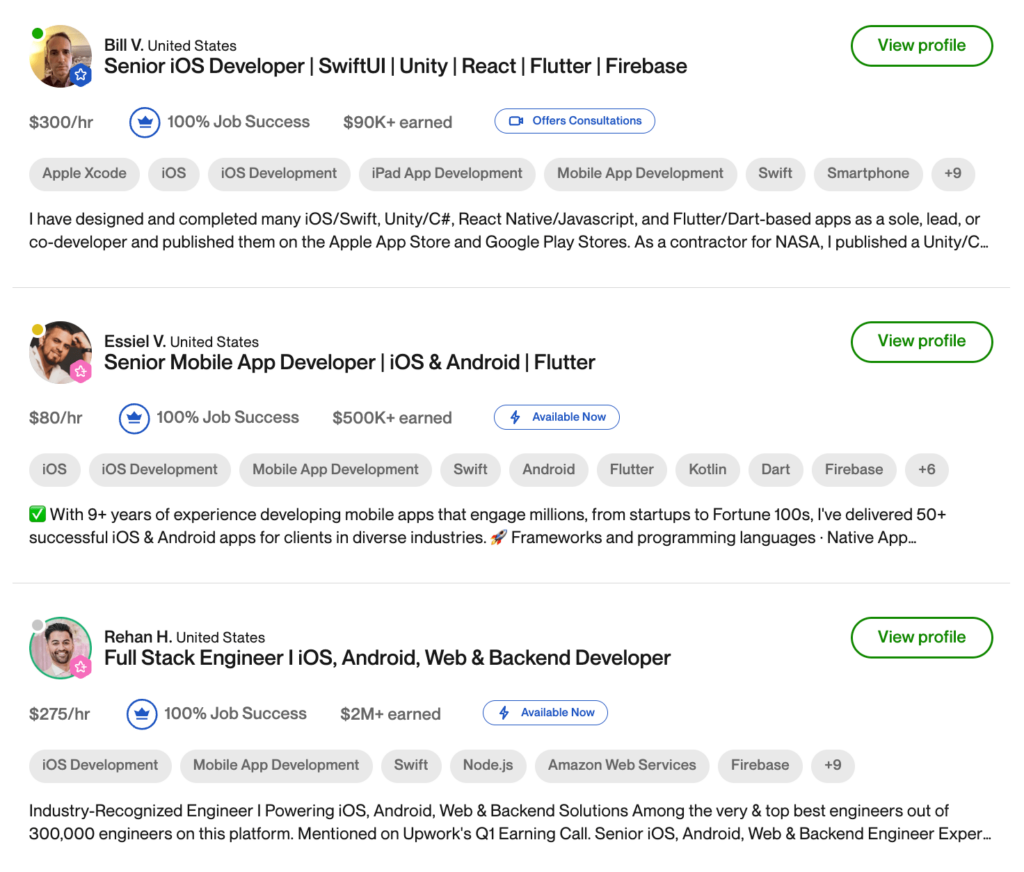
10. Rust
The Rust programming language is designed for safety, concurrency, and practicality. By emphasizing secure memory management, it guarantees thread safety and prevents segmentation faults.
Rust’s speed and memory efficiency make it ideal for embedded systems where resource utilization is key.
Applications of Rust across projects and industries
Rust’s safety and speed have made it increasingly popular for system-level programming, such as developing operating systems, game engines, and browser components.
For instance, Mozilla’s Servo browser engine is built using Rust. Its memory-efficient architecture is also valuable for embedded systems, IoT devices, and applications where low-level control is paramount.
Additionally, Rust is used in blockchain projects and web development with frameworks like Rocket and Actix.
Skills needed for Rust developers
- A solid understanding of systems programming concepts like memory management, concurrency, and threading.
- Familiarity with Rust’s ownership model.
- Knowing Cargo, Rust’s package manager.
- Writing efficient, idiomatic Rust code.
- Experience with C or C++.
Compatibility of Rust
Rust supports development across web, desktop, and embedded platforms. Its versatility enables developers to create web servers, desktop applications, and even low-level firmware for microcontrollers.
Benefits of Rust
- Memory Safety: Prevents memory leaks and data races through strict ownership and borrowing rules.
- High Performance: Compiled directly to machine code, Rust is exceptionally fast, rivaling C and C++.
- Concurrency: Guarantees thread safety, making concurrent programming easier to implement.
Drawbacks of Rust
- Learning Curve: Rust’s strict memory management can be challenging to learn, particularly for beginners.
- Mature Ecosystem: While growing, Rust’s ecosystem remains smaller than more established languages.
The popularity of Rust over the years
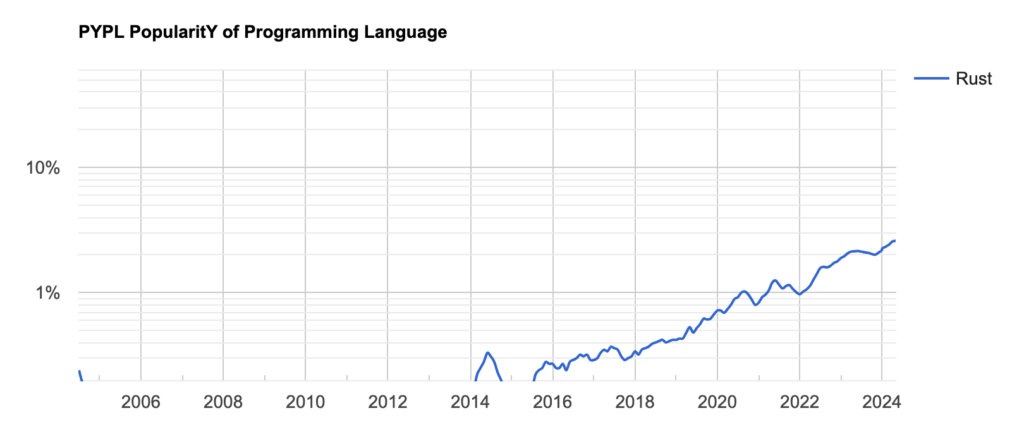
Rust developers’ salary
Traditionally, Rust developers make $90,000 to $200,000 per year, reflecting their specialized skills.
In the U.S., the average base salary is around $150,000, with an average hourly rate of $72.
Rust developers are in high demand due to the language’s growing adoption in critical performance and safety-focused applications.
Upwork Data
Rust developer average hourly rate – 95$ (for a 100% job success rate)

11. Objective-C
Objective-C is a general-purpose, object-oriented programming language created in the early 1980s. It became the primary language for developing iOS, macOS, and other Apple software before the introduction of Swift.
Objective-C is still important for maintaining and improving legacy Apple apps, even though its popularity has declined.
Applications of Objective-C across projects and industries
Objective-C was integral to developing iOS and macOS applications, forming the basis of early apps for iPhone, iPad, and Mac computers.
Although Swift has largely supplanted it in new projects, Objective-C remains relevant for maintaining older Apple apps and frameworks.
Developers frequently use it with Cocoa and Cocoa Touch, the core frameworks that power Apple’s graphical user interfaces.
Skills needed for Objective-C developers
Developers proficient in C will find Objective-C relatively easy to learn due to their syntactic similarities. Key skills include:
- Understanding object-oriented programming principles
- Working with Apple’s Cocoa and Cocoa Touch frameworks
- Using Xcode as the primary development environment.
- Familiarity with debugging tools and version control.
Compatibility of Objective-C
Objective-C’s primary focus is on Apple’s platforms, including iOS, macOS, and watchOS. However, it can be extended to web applications via hybrid app frameworks and integrated with other languages like Swift.
Benefits of Objective-C
- Toolkits and Libraries: Offers a vast range of frameworks and libraries, simplifying application development.
- Familiar Syntax: Developers familiar with C will find Objective-C’s syntax relatively straightforward.
- Legacy Support: Enables developers to maintain and improve existing Apple applications.
Drawbacks of Objective-C
- Declining Popularity: Swift has overshadowed Objective-C, limiting its use in new projects.
- Verbose Syntax: Objective-C requires a more verbose syntax than Swift, which can make coding cumbersome.
The popularity of Objective-C over the years
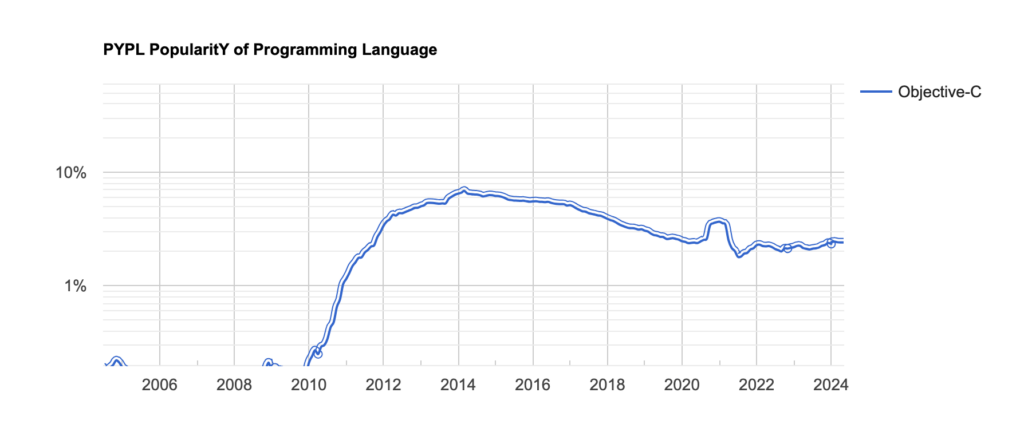
Objective-C developers’ salary
According to experience and expertise, Objective-C developers make between $80,000 and $180,000 per year.
In the U.S., the average base salary is $137,500, with an average hourly rate of $66.
Upwork Data
Objective-C developer average hourly rate – 75$ (for a 100% job success rate)
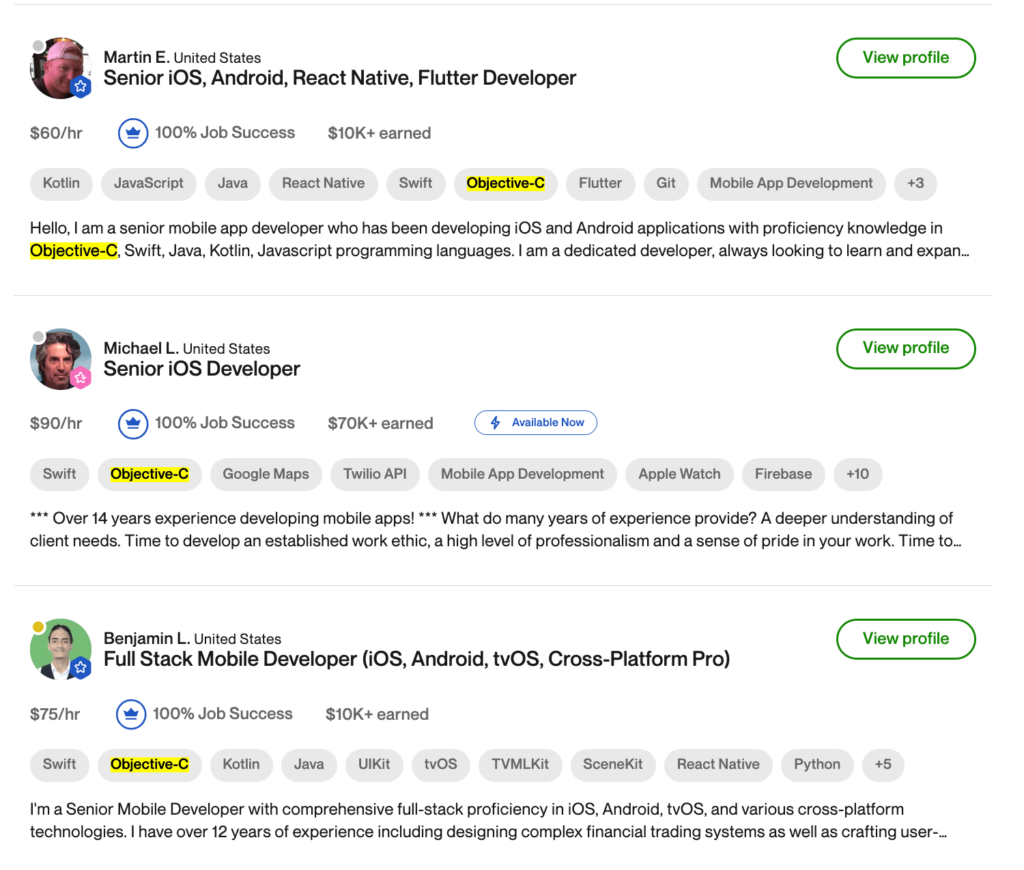
12. Go (Golang)
Go, also known as Golang, is a statically typed, compiled programming language created by Google in 2009. It was developed to handle the complexity of building large-scale software systems efficiently.
Golang is notable for its clean, readable syntax and an extensive standard library that offers a broad range of features.
Applications of Go across projects and industries
Go excels at building scalable, high-performance software systems, making it ideal for cloud computing, distributed systems, and backend web services.
Companies like Google, Twitter, Netflix, and Uber utilize Golang for projects that require efficient concurrency, fast compilation, and smooth deployment.
Go’s cross-platform compatibility allows developers to build applications for web, mobile, desktop, and server environments.
Skills needed for Go developers
To work proficiently with Go, developers need a strong grasp of its strict typing system, garbage collection, and concurrency model, which includes goroutines and channels.
Familiarity with Go’s testing tools, dependency management with Go modules, and working with the standard library is crucial for building efficient applications.
Compatibility of Go
Go is designed to be cross-platform, allowing developers to write software that can be compiled for web, desktop, mobile, and server platforms. It’s particularly effective in cloud-based architectures due to its lightweight binaries and efficient memory management.
Benefits of Go
- Efficient Concurrency: Go’s goroutines and channels make concurrency simpler and more efficient.
- Clean Syntax: Readable, straightforward syntax reduces coding errors and boosts productivity.
- Cross-Platform: Can be compiled for various platforms, simplifying development and deployment.
Drawbacks of Go
- Limited Features: Lacks some advanced features found in other languages, such as generics, which can increase code repetition.
- Learning Curve: Newcomers to static typing may find adapting to Go’s strict type system challenging.
The popularity of Go over the years
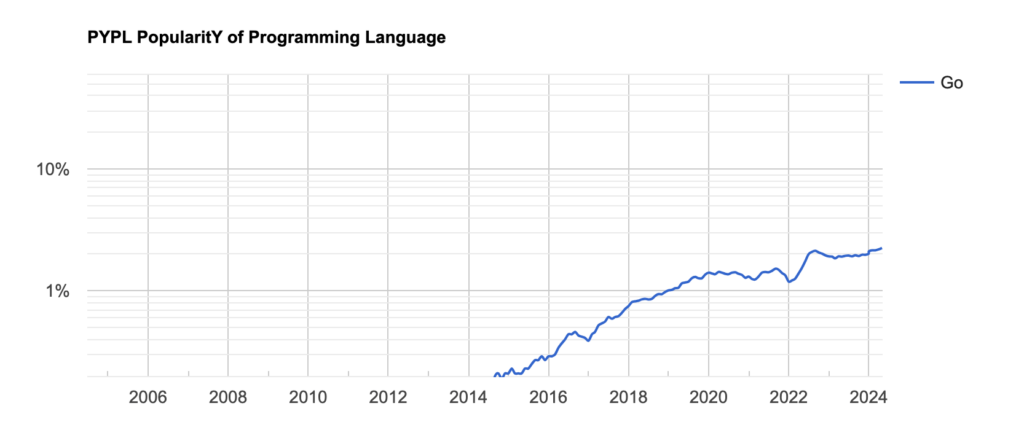
Go developers’ salary
A Go developer‘s salary traditionally ranges from $80,000 to $180,000, depending on expertise.
In the U.S., the average base salary is approximately $135,720, with an average hourly rate of $65.
As more companies adopt Go for large-scale projects, experienced developers remain in high demand.
Upwork Data
Go developer average hourly rate – 77$ (for a 100% job success rate)

13. Kotlin
Kotlin is a statically typed programming language that runs across platforms.
Created by JetBrains in 2011 and officially endorsed by Google for Android development, Kotlin can build apps for mobile devices, server-side applications, and web platforms.
Applications of Kotlin across projects and industries
Kotlin is widely used in developing Android apps and is fully interoperable with Java, making it possible to run on the Java Virtual Machine (JVM).
The language also allows seamless conversion to JavaScript or native code, enabling cross-platform development with a single codebase.
Its adaptability has made it popular among large companies such as Pinterest, Netflix, Trello, Uber, and Evernote.
Skills needed for Kotlin developers
To effectively use Kotlin, developers should be familiar with object-oriented programming and the core features of Java, given their compatibility.
Understanding Kotlin’s concise syntax, type inference, and extension functions will be crucial for writing efficient code.
Familiarity with Android development tools, such as Android Studio, and web frameworks, like Ktor, will also be advantageous.
Compatibility of Kotlin
Kotlin’s compatibility spans the web, mobile, desktop, and server platforms. Its ability to run on the JVM, compile to JavaScript, and natively on mobile devices makes it ideal for cross-platform development.
Benefits of Kotlin
- Java Interoperability: Allows seamless integration with existing Java projects and libraries.
- Concise Syntax: Reduces boilerplate code, leading to increased productivity and easier maintenance.
- Cross-Platform: Can target multiple platforms from a single codebase, making it ideal for modern app development.
Drawbacks of Kotlin
- Tooling Issues: Some IDE tools, particularly for debugging, can still be less mature compared to Java.
- Learning Curve: Developers unfamiliar with Java or similar languages may need time to adapt to Kotlin’s features.
The popularity of Kotlin over the years

Kotlin developers’ salary
Historically, Kotlin developers have made between $85,000 and $170,000 per year, depending on their experience.
The average base salary in the U.S. is $130,000, with an average hourly rate of $63.
Upwork Data
Kotlin developer average hourly rate – 75$ (for a 100% job success rate)

14. SQL
SQL (Structured Query Language) is the standard language used to query, manipulate, and manage data within relational databases.
Since SQL is declarative, users can define desired results without specifying how to get them.
Due to this approach, SQL has become the most widely used database query language in the world.
Applications of SQL across projects and industries
SQL is essential in any project involving data management, including web applications, financial systems, healthcare databases, and CRM software.
It enables data scientists, analysts, and developers to efficiently access, analyze, and transform large datasets.
Whether retrieving sales data, managing inventory, or generating business reports, SQL plays a critical role in data-driven decision-making across all industries.
Skills needed for SQL developers
To be proficient in SQL, one should understand relational database concepts such as tables, joins, and indexes.
Experience writing queries using SQL commands like `SELECT`, `INSERT`, `UPDATE`, and `DELETE` is fundamental.
Familiarity with database management systems (DBMS) like MySQL, PostgreSQL, or SQL Server is beneficial, as is knowledge of data normalization and optimization techniques to enhance query performance.
Compatibility of SQL
SQL can be used across various platforms, including web, desktop, and server environments.
It is supported by a wide range of relational database management systems (RDBMS) like Oracle, Microsoft SQL Server, and SQLite, ensuring compatibility with different operating systems and software architectures.
Benefits of SQL
- Standardized Language: Provides a consistent syntax across various database systems, simplifying learning and adoption.
- Powerful Query Capabilities: Enables complex data retrieval and manipulation with relatively simple commands.
- Interoperability: Integrates well with different programming languages and platforms.
Drawbacks of SQL
- Complex Joins: Complex queries involving multiple joins can become difficult to write and maintain.
- Scalability Issues: Some traditional RDBMS implementations may struggle with very large-scale data due to architectural limitations.
SQL developers’ salary
There have been big variations in SQL developer salaries over the years, depending on experience and industry.
In the U.S., the average base salary is $109,781, with an average hourly rate of $53.
SQL skills remain in high demand since databases are used for critical business functions.
Upwork Data
SQL developer average hourly rate – 141$ (for a 100% job success rate)
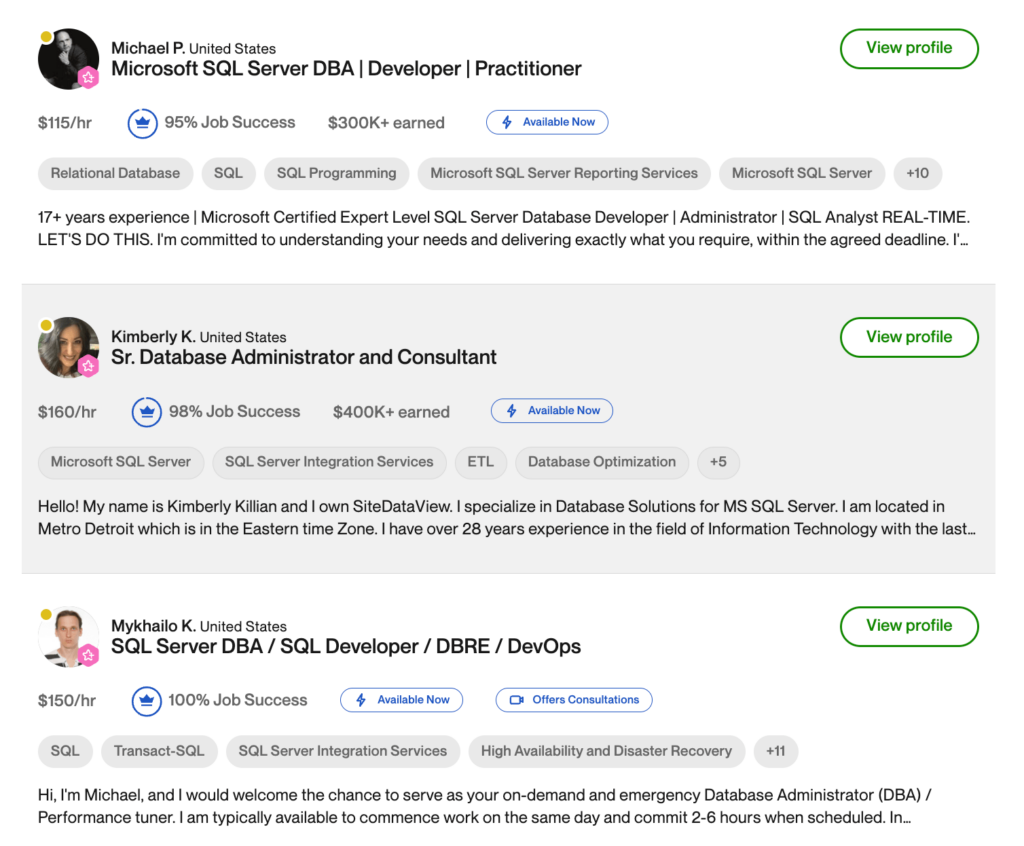
15. Ruby
Ruby, developed in the 1990s, is known for its simple syntax and ease of learning. It was designed to be human-friendly while maintaining flexibility through an object-oriented architecture that supports procedural and functional programming styles.
Ruby on Rails (RoR), a popular web application framework built on Ruby, has contributed significantly to the language’s growth and appeal.
Applications of Ruby across projects and industries
Ruby is predominantly used in web development due to Ruby on Rails, which simplifies building feature-rich applications.
Companies like Airbnb, GitHub, and Shopify leverage Ruby on Rails to create scalable and efficient web applications.
Ruby is also used in automation scripts, data processing, and building software prototypes, thanks to its flexibility and expressiveness.
Skills needed for Ruby developers
It’s important to understand Ruby’s object-oriented principles and syntax if you want to master it.
Familiarity with Ruby on Rails is crucial for web development projects, while knowledge of debugging tools, testing frameworks, and package management systems like RubyGems will significantly improve productivity.
Understanding RESTful architecture and MVC design patterns will also be advantageous.
Compatibility of Ruby
Ruby can be used for web development, desktop applications, and automation scripts, offering cross-platform compatibility across Windows, macOS, and Linux. Its use in web development is most prevalent due to Ruby on Rails.
Benefits of Ruby
- Human-Friendly Syntax: Ruby is designed to read like a natural language, making it easier to learn and write.
- Flexible Architecture: Supports procedural, functional, and object-oriented programming paradigms.
- Active Community: A large, supportive developer community provides comprehensive libraries and resources.
Drawbacks of Ruby
- Performance: Ruby can be slower than other programming languages, which may affect performance-sensitive applications.
- Memory Usage: Ruby applications can consume more memory compared to alternatives like Python.
The popularity of Ruby over the years
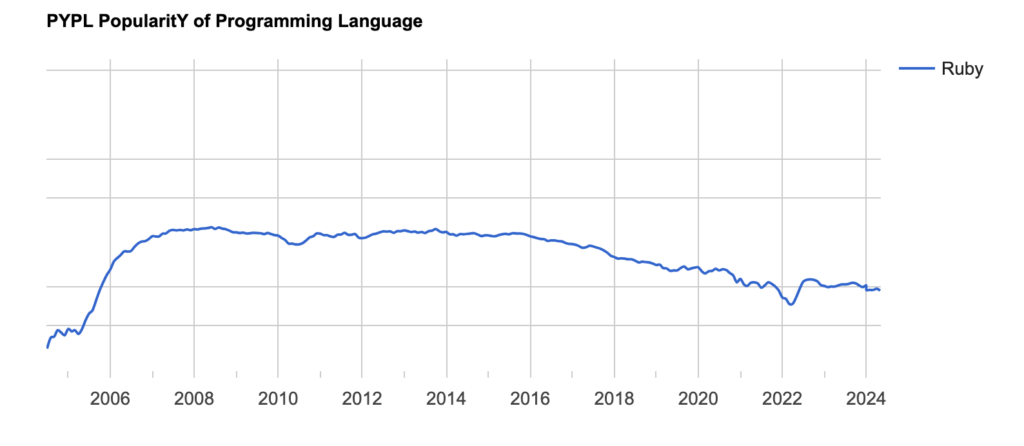
Ruby developers’ salary
According to historical data, Ruby developers earn between $80,000 and more than $160,000 annually, depending on their level of experience and industry.
The average base salary in the U.S. is $130,000, and the average hourly wage is $63.
Ruby developers continue to be sought after due to the language’s widespread adoption in web development.
Upwork Data
Ruby developer average hourly rate – 65$ (for a 100% job success rate)

16. VBA
VBA (Visual Basic for Applications) is a high-level programming language primarily used to create macros, user-defined functions, and add-ons for Microsoft Office applications.
The language’s syntax is similar to Visual Basic 6.0, and it supports object-oriented programming, which allows developers to create custom objects.
Applications of VBA across projects and industries
VBA integrates seamlessly with Microsoft Office applications like Word, Excel, PowerPoint, and Access.
It enables users to automate repetitive tasks, build custom data processing workflows, and create user-defined functions.
For instance, VBA is widely used in financial analysis to automate data consolidation in Excel, generate custom reports in Word, or manage databases in Access.
Skills needed for VBA developers
- Familiarity with syntax and object-oriented programming principles.
- Understanding the application object models of Office software.
- Knowledge of debugging tools, error handling, and best practices for writing reusable code.
Compatibility of VBA
VBA is compatible across Microsoft Office applications on both Windows and macOS. While its primary focus is desktop software, VBA can also interact with web services via APIs or databases through ODBC connections.
Benefits of VBA:
- Task Automation: Reduces repetitive manual work by automating common Office tasks.
- Custom Solutions: Enables the creation of user-defined functions and add-ons tailored to specific workflows.
- Integrated Environment: Embedded within Office applications, making it readily accessible.
Drawbacks of VBA:
- Limited Scope: Primarily used for Microsoft Office automation, limiting applicability beyond that ecosystem.
- Legacy Language: As a legacy language, VBA lacks some modern features found in newer programming tools.
The popularity of VBA over the years
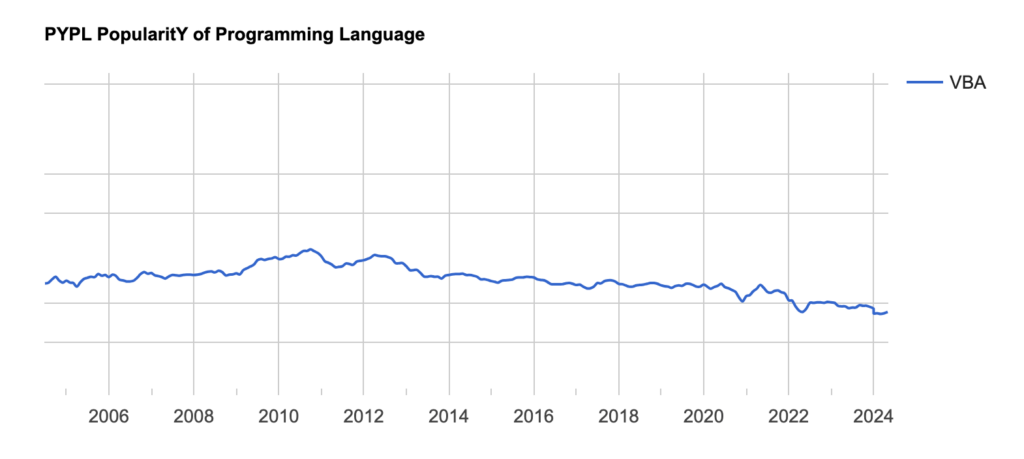
VBA developers’ salary
The salary range for VBA developers has historically ranged from $55,000 to over $120,000, depending on expertise and industry.
In the U.S., the average base salary is around $97,500, with an average hourly rate of $47.
Although VBA doesn’t have a wide scope, it’s still effective for automating Office workflows and processes.
Upwork Data
VBA developer average hourly rate – 90$ (for a 100% job success rate)

17. Powershell
PowerShell, released in 2006 and built on the .NET framework, is a powerful command-line shell and scripting language.
It provides features like object-oriented programming, strongly typed variables, remote execution, and file system navigation.
With its support for COM objects, third-party add-ons, and modules, PowerShell offers a flexible automation environment.
Applications of Powershell across projects and industries
PowerShell is primarily designed for system administrators and IT professionals to automate administrative tasks, manage systems, and streamline workflows.
It’s crucial for maintaining server environments, coordinating software deployments, and managing Active Directory.
Remote script execution makes IT teams more efficient at performing updates, monitoring performance, and configuring networks.
Skills needed for Powershell developers
To work proficiently with PowerShell, users should understand the command-line environment, scripting principles, and object-oriented programming basics.
Familiarity with the .NET framework and Windows Management Instrumentation (WMI) enhances productivity, while knowledge of security best practices ensures safe script execution.
Developers should also be comfortable writing reusable functions and modules.
Compatibility of Powershell
PowerShell is compatible with Windows, Linux, and macOS, enabling cross-platform scripting. It can interact with web services via APIs and manage various software platforms, making it suitable for mixed-environment automation.
Benefits of Powershell
- System Management: Offers robust tools for managing servers, network devices, and applications.
- Cross-Platform: Runs on multiple operating systems, enabling a unified approach to automation.
- Secure: Detects malicious activities and provides fine-grained control over script execution.
Drawbacks of Powershell
- Learning Curve: The command-line environment may pose challenges for those unfamiliar with scripting.
- Execution Time: Some scripts may run slower compared to compiled languages due to their interpreted nature.
The popularity of Powershell over the years
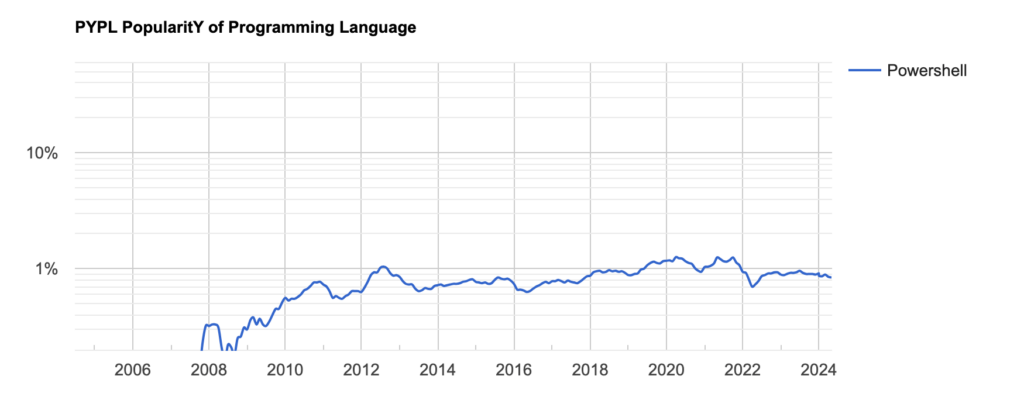
Powershell developers’ salary
Historically, salaries for PowerShell developers range from $70,000 to over $150,000 annually, based on experience and industry.
In the U.S., the average base salary is $119,600, with an average hourly rate of $59.
PowerShell skills remain in demand due to the language’s importance in system administration and IT automation.
Upwork Data
Powershell developer average hourly rate – 96$ (for a 100% job success rate)

18. Ada
Ada is a statically typed, structured, and imperative programming language.
Known for its reliability and efficiency, Ada is commonly used in large-scale software systems requiring high standards of safety and performance.
Applications of Ada across projects and industries
Ada is widely employed in developing real-time systems, such as avionics software, transportation systems, and medical devices.
Its features like exception handling, data abstraction, object-oriented programming, and strong type safety ensure that applications maintain integrity and handle errors gracefully.
Ada’s structured syntax makes it suitable for mission-critical software in defense, aerospace, and industrial automation, where failure is not an option.
Skills Needed for Ada developers
Proficiency in Ada requires understanding its strong typing system, tasking model for concurrency, and its object-oriented features.
Developers should be comfortable with exception handling and data abstraction techniques.
Familiarity with software engineering practices like code readability, testing, and maintenance is crucial due to the strict requirements often associated with Ada projects.
Compatibility of Ada
Ada is cross-platform, allowing development for desktop, web, and embedded systems. The language’s versatility makes it suitable for various computing environments, including those requiring high-integrity software.
Benefits of Ada
- Reliability: Offers exceptional reliability and fault tolerance through strong typing and exception handling.
- Readability: Clear, structured syntax makes it easier to write and maintain complex software.
- Safety Features: Type safety and other features ensure strict adherence to software safety requirements.
Drawbacks of Ada
- Limited Adoption: Not as widely adopted as other languages, which may limit community support and resources.
- Steep Learning Curve: The strict syntax and safety features require a thorough understanding for effective use.
The popularity of Ada over the years
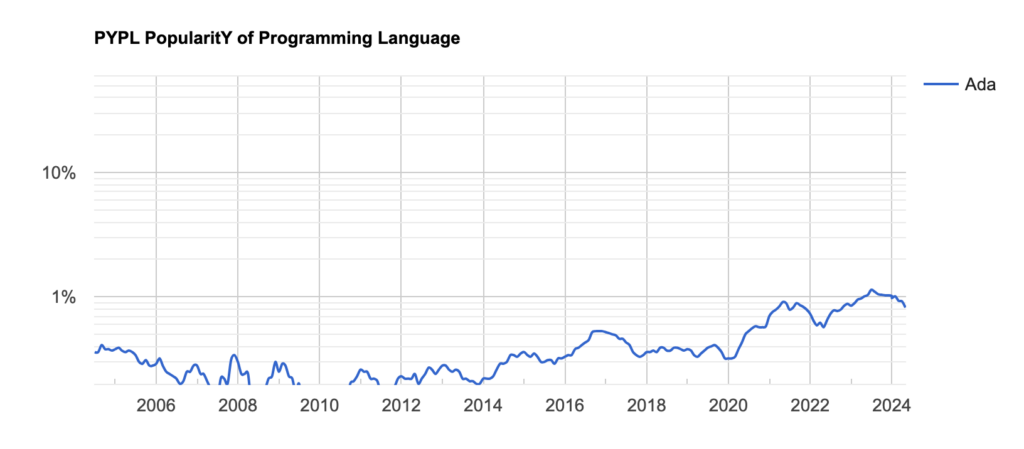
Ada developers’ salary
It is common for Ada developers to earn salaries ranging from $90,000 to over $160,000, depending on the industry and the level of experience.
A typical U.S. base salary is $127,500, with an average hourly wage of $61.
Demand for Ada developers remains steady due to the language’s importance in mission-critical and real-time applications.
Upwork Data
Ada developer average hourly rate – 56$ (for a 100% job success rate)

19. Scala
Scala is a type-safe, general-purpose programming language that runs on the Java Virtual Machine.
It seamlessly integrates the principles of both object-oriented and functional programming, making it highly versatile for reducing and eliminating bugs in large, complex applications.
Applications of Scala across projects and industries
Scala is suitable for any task that Java handles, offering similar platform compatibility but with enhanced features.
Companies like Netflix, Twitter, and The New York Times utilize Scala for tasks like data processing, web services, and backend systems.
Its flexibility makes it ideal for building scalable, high-performance applications in data science, financial modeling, and software development.
Skills needed for Scala developers
- A firm grasp of object-oriented and functional programming principles.
- Familiarity with the Java or JVM languages
- Mastery of advanced features like pattern matching, higher-order functions, and immutability.
Compatibility of Scala
Scala’s integration with the JVM allows it to run on any platform that supports Java, such as the web, desktop, and server environments. Its compatibility with popular big data tools like Apache Spark makes it an excellent choice for data science and analytics projects.
Benefits of Scala
- Type Safety: Strong type checking reduces the likelihood of runtime errors and ensures better code quality.
- Flexibility: Combines object-oriented and functional programming, providing flexibility in application design.
- Java Compatibility: Can use Java libraries and frameworks seamlessly, simplifying code integration.
Drawbacks of Scala
- Complexity: The combination of paradigms can make Scala challenging to learn and master.
- Compile Time: Programs may take longer to compile compared to other JVM languages.
The popularity of Scala over the years
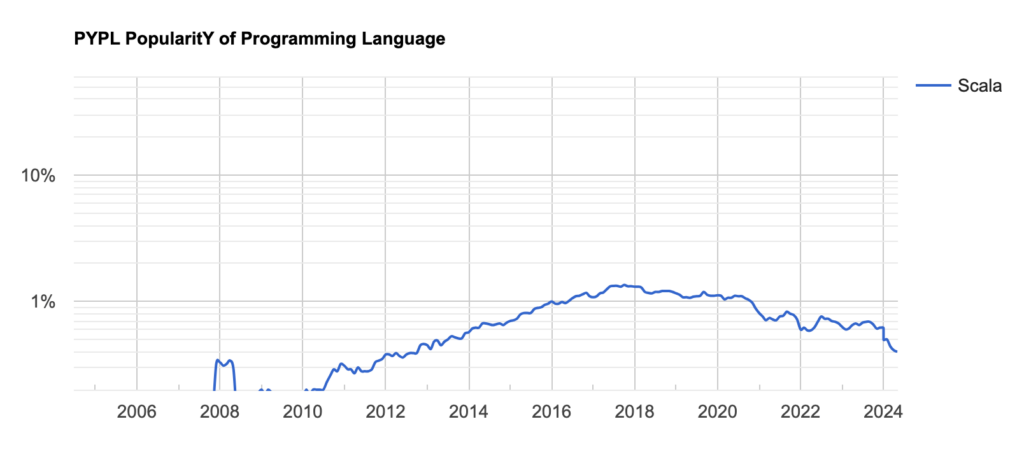
Scala developers’ salary
Scala developers have historically made between $80,000 and $180,000 annually, depending on experience.
In the U.S., the average base salary is $135,850, with an average hourly rate of $65.
As more companies use Scala for big data and web development, the demand for skills will continue to rise.
Upwork Data
Scala developer average hourly rate – 80$ (for a 100% job success rate)
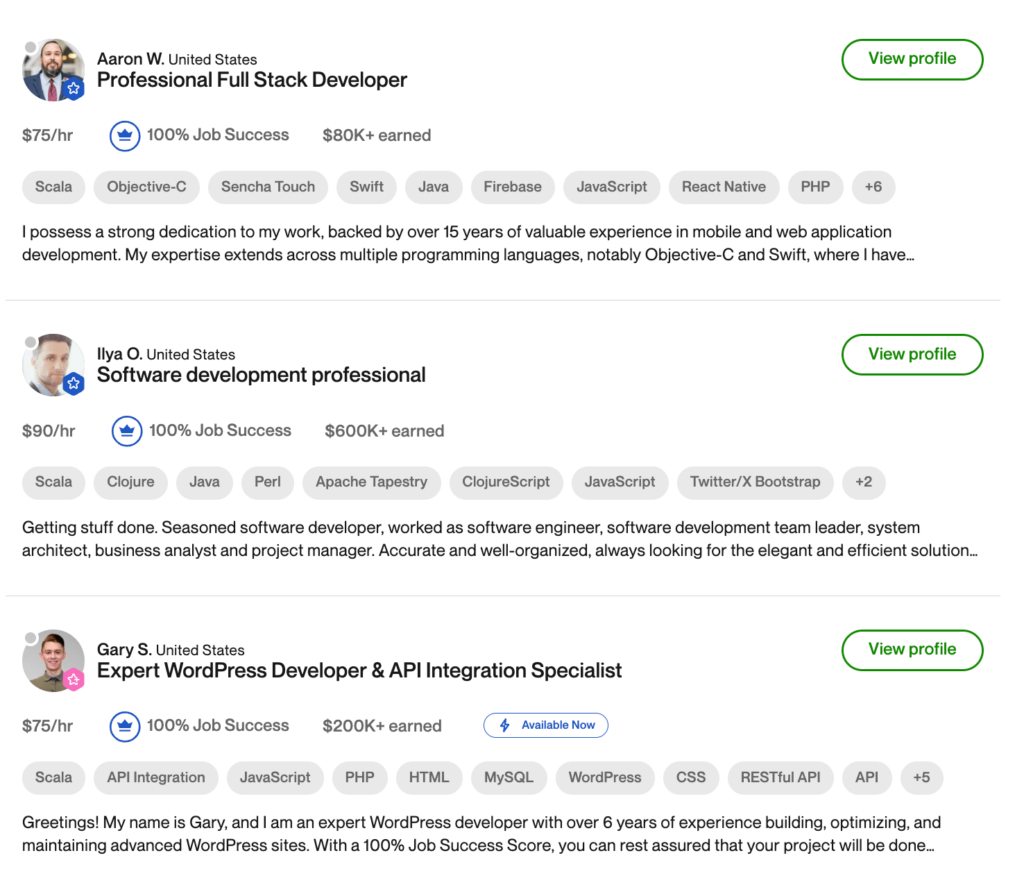
20. Perl
The Perl programming language was originally developed by Larry Wall in 1987 as a Unix scripting language to simplify report generation.
Although not formally an acronym, it is often referred to as “Practical Extraction and Report Language.” Over the years, Perl has evolved significantly through numerous updates and revisions.
Applications of Perl across projects and industries
Perl’s adaptability has made it a staple in various fields. It’s used extensively for text manipulation, system administration, web development, and network programming.
Additionally, Perl is crucial for bioinformatics, financial analysis, and data processing tasks, making it a versatile choice across industries that require robust data parsing and report generation.
Skills needed for Perl developers
To work efficiently with Perl, developers need a solid understanding of regular expressions, data structures, and text manipulation techniques.
Familiarity with system commands, Unix utilities, and Perl modules like DBI (for database interaction) will enhance productivity.
Understanding Perl’s object-oriented features and best practices for writing maintainable code is also beneficial.
Compatibility of Perl
Perl is cross-platform, supporting web, desktop, and server environments on operating systems like Windows, macOS, and Linux.
It also integrates well with other languages and database systems, making it suitable for complex web services and automation scripts.
Benefits of Perl
- Text Processing: Perl excels at text manipulation with its powerful regular expressions.
- Cross-Platform: Works consistently across operating systems, providing flexibility in development.
- Rich Library Support: CPAN (Comprehensive Perl Archive Network) offers thousands of modules for various tasks.
Drawbacks of Perl
- Readability: Perl’s syntax can be hard to read, particularly for those unfamiliar with the language.
- Declining Popularity: Perl’s usage has declined in favor of newer languages like Python and Ruby.
Perl developers’ salary
Historically, the salary range for Perl developers has been between $70,000 and over $150,000 per year, based on their level of expertise and industry.
In the U.S., the average base salary is $115,000, with an average hourly rate of $55.
Upwork Data
Perl developer average hourly rate – 74$ (for a 100% job success rate)

Sources used:
U.S. Bureau of Labor Statistics
Talent.com
PYPL


